Honda FIT 2009 Owner's Manual

Main Menu
Introduction
Congratulations! Your selection of a 2009 Honda Fit was a wise investment. It will give you years of driving pleasure.
One of the best ways to enhance the enjoyment of your new vehicle is to read this manual. In it, you will learn how to operate its driving controls and convenience items. Afterwards, keep this owner's manual in your vehicle so you can refer to it at any time.
Several warranties protect your new vehicle. Read the warranty booklet thoroughly so you understand the coverages and are aware of your rights and responsibilities.
Maintaining your vehicle according to the maintenance minder shown in the instrument panel helps to keep your driving trouble-free while it preserves your investment. When your vehicle needs maintenance, keep in mind that your dealer's staff is specially trained in servicing the many systems unique to your vehicle. Your dealer is dedicated to your satisfaction and will be pleased to answer any questions and concerns.
As you read this manual, you will find information that is preceded by a
 symbol. This information is intended to help you avoid damage to your vehicle, other property, or the environment.
symbol. This information is intended to help you avoid damage to your vehicle, other property, or the environment.
2009 Fit |
i |

Main Menu
Introduction
California Proposition 65 Warning
WARNING: This product contains or emits chemicals known to the State of California to cause cancer and birth defects or other reproductive harm.
Event Data Recorders
This vehicle is equipped with one or more devices commonly referred to as event data recorders. These devices record front seat belt use, front passenger seat occupancy, airbag deployment data, and the failure of any airbag system component. This data belongs to the vehicle owner and may not be accessed by anyone else except as legally required or with the permission of the vehicle owner.
Service Diagnostic Recorders
This vehicle is equipped with service-related devices that record information about powertrain performance. The data can be used to verify emissions law requirements and/or help technicians diagnose and solve service problems. It may also be combined with data from other sources for research purposes, but it remains confidential and is never linked to the vehicle owner.
ii |
2009 Fit |
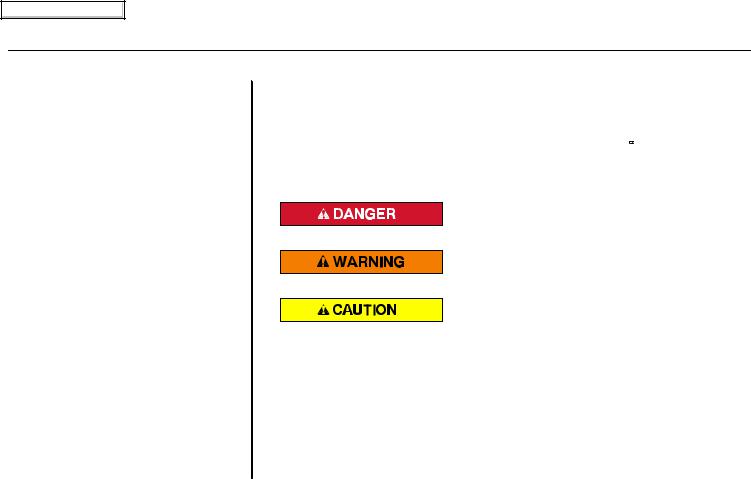
Main Menu
A Few Words About Safety
Your safety, and the safety of others, is very important. And operating this vehicle safely is an important responsibility.
To help you make informed decisions about safety, we have provided operating procedures and other information on labels and in this manual. This information alerts you to potential hazards that could hurt you or others.
Of course, it is not practical or possible to warn you about all the hazards associated with operating or maintaining your vehicle. You must use your own good judgement.
You will find this important safety information in a variety of forms, including:
●Safety Labels on the vehicle.
●Safety Messages preceded by a safety alert symbol  and one of three signal words: DANGER, WARNING, or CAUTION.
and one of three signal words: DANGER, WARNING, or CAUTION.
These signal words mean:
You WILL be KILLED or SERIOUSLY
HURT if you don't follow instructions.
You CAN be KILLED or SERIOUSLY
HURT if you don't follow instructions.
You CAN be HURT if you don't follow instructions.
●Safety Headings such as Important Safety Reminders or Important Safety Precautions.
●Safety Section such as Driver and Passenger Safety.
●Instructions how to use this vehicle correctly and safely.
This entire book is filled with important safety information please read it carefully.
2009 Fit |
iii |

2009 Fit Online Reference Owner's Manual
Contents
Owner's Identification Form |
|
Introduction .......................................................................................................................................................... |
i |
A Few Words About Safety .............................................................................................................................. |
iii |
Your Vehicle at a Glance (main controls) .................................................................................................... |
3 |
Driver and Passenger Safety (seat belts, SRS, and child protection) .................................................... |
5 |
Instruments and Controls (indicators, gauges, dashboard, steering wheel, and other convenience items) ............. |
57 |
Features (heating and cooling, audio, steering wheel, security, and cruise control) ................................. |
109 |
Before Driving (fuel, vehicle break-in, and cargo loading) ...................................................................... |
197 |
Driving (engine and transmission operation) ................................................................................................ |
213 |
Maintenance (minder, fluid checking, minor services, and vehicle storage)........................................... |
243 |
Taking Care of the Unexpected (flat tire, dead battery, overheating, and fuses) .............................. |
283 |
Technical Information (vehicle specifications, tires, and emissions controls) ....................................... |
315 |
Warranty and Customer Relations (U. S. and Canada only) (warranty and contact information) ... |
331 |
Index ........................................................................................................................................................................ |
I |
Service Information Summary ( fluid capacities and tire pressures) |
|
00X31-TK6-6003 |
1 |

Main Menu
Overview of Contents
Contents
A convenient reference to the sections in this manual.
Your Vehicle at a Glance
A quick reference to the main controls in your vehicle.
Driver and Passenger Safety
Important information about the proper use and care of your vehicle's seat belts, an overview of the supplemental restraint system, and valuable information on how to protect children with child restraints.
Instruments and Controls
Explains the purpose of each instrument panel indicator and gauge, and how to use the controls on the dashboard and steering column.
Features
How to operate the heating and air conditioning system, the audio system, and other convenience features.
Before Driving
What gasoline to use, how to breakin your new vehicle, and how to load luggage and other cargo.
Driving
The proper way to start the engine, shift the transmission, and park.
Maintenance
The maintenance minder shows you when you need to take your vehicle to the dealer for maintenance service. There is also a list of things to check and instructions on how to check them.
Taking Care of the Unexpected
This section covers several problems motorists sometimes experience, and details how to handle them.
Technical Information
ID numbers, dimensions, capacities, and technical information.
Warranty and Customer Relations (U.S. and Canada only)
A summary of the warranties covering your new vehicle, and how to contact us for any reason. Refer to your warranty manual for detailed information.
Index
Service Information Summary
A summary of the information you need when you pull up to the fuel pump.
2 |
2009 Fit |
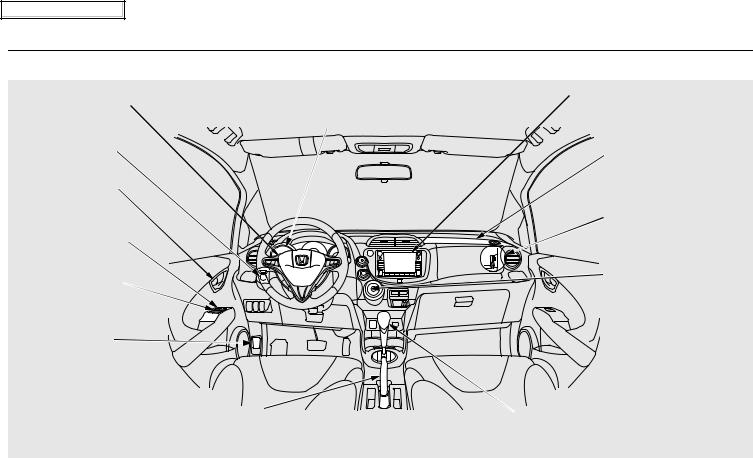
Main Menu
Your Vehicle at a Glance
DRIVER'S FRONT AIRBAG (P. 9, 25)
MIRROR CONTROLS (P. 101)
DOOR LOCK TAB (P. 81)
POWER DOOR LOCK MASTER SWITCH (P. 81)
POWER WINDOW SWITCHES
(P. 100)
HOOD RELEASE HANDLE
(P. 200)
INSTRUMENT PANEL
INDICATOR (P. 60)
GAUGES (P. 68)
PARKING BRAKE (P. 102)
Vehicle with navigation system is shown.
: If equipped
AUDIO SYSTEM |
|
|
|
||
(P. 115, 143) |
|
|
NAVIGATION SYSTEM |
Your |
|
PASSENGER'S FRONT |
||
aatVehicle |
||
USB ADAPTER CABLE |
||
AIRBAG |
|
|
(P. 9, 25) |
|
|
(P. 130, 137, 171, 178) |
Glance |
|
|
||
HEATING/COOLING |
|
|
CONTROLS |
|
|
(P. 110) |
|
AUTOMATIC TRANSMISSION (P. 219)
MANUAL TRANSMISSION (P. 217)
CONTINUED
2009 Fit |
3 |
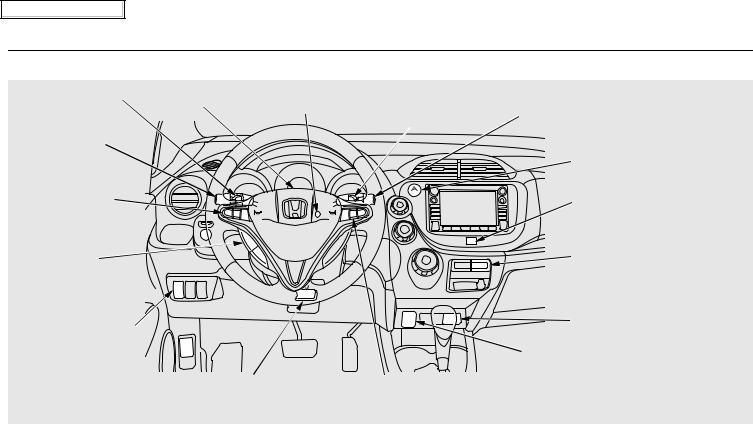
Main Menu
Your Vehicle at a Glance
PADDLE SHIFTER |
HORN 1 INSTRUMENT PANEL |
PADDLE SHIFTER |
WINDSHIELD WIPERS/WASHERS |
(DOWNSHIFT) 2 |
BRIGHTNESS (P. 76) |
(UPSHIFT) 2 |
(P. 73) |
(P. 224) |
|
(P. 224) |
|
|
|
|
|
HEADLIGHTS/ |
|
|
|
TURN SIGNAL/ |
|
|
HAZARD WARNING |
FOG LIGHTS 2 |
|
|
|
|
|
BUTTON |
|
(P. 74) |
|
|
|
|
|
(P. 76) |
|
|
|
|
|
REMOTE AUDIO |
|
|
PASSENGER |
CONTROL |
|
|
AIRBAG OFF |
BUTTONS 2 |
|
|
INDICATOR |
(P. 189) |
|
|
(P. 31) |
NAVIGATION |
|
|
REAR WINDOW |
SYSTEM VOICE |
|
|
DEFOGGER/ |
CONTROL |
|
|
HEATED MIRROR |
BUTTONS 3 |
|
|
BUTTON 2 |
|
|
|
(P. 76/102) |
VEHICLE STABILITY
ASSIST (VSA)
SYSTEM OFF
SWITCH 2 |
|
(P. 234) |
CRUISE CONTROL BUTTONS 2 |
STEERING WHEEL ADJUSTMENTS |
|
(P. 77) |
(P. 194) |
Vehicle with navigation system is shown.
AUXILIARY INPUT JACK (P. 190)
ACCESSORY POWER SOCKET (P. 106)
1: To use the horn, press the center pad of the steering wheel.2: If equipped.
3: Only on vehicles equipped with navigation system. Refer to the navigation system manual.
4 |
2009 Fit |

Main Menu
Driver and Passenger Safety
This section gives you important information about how to protect yourself and your passengers. It shows you how to use seat belts. It explains how your airbags work. And it tells you how to properly restrain infants and children in your vehicle.
Important Safety Precautions ........... |
6 |
|
Your Vehicle's Safety Features ......... |
7 |
|
Seat Belts .................................... |
8 |
|
Airbags........................................ |
9 |
|
Protecting Adults and Teens .......... |
11 |
|
1. |
Close and Lock the Doors ...... |
11 |
2. |
Adjust the Front Seats ............ |
11 |
3. |
Adjust the Seat-Backs............. |
12 |
4. |
Adjust the Head Restraints ..... |
13 |
5. |
Fasten and Position the Seat |
|
|
Belts .................................. |
14 |
6. |
Maintain a Proper Sitting |
|
|
Position ............................. |
15 |
Advice for Pregnant Women ...... |
16 |
|
Additional Safety Precautions..... |
17 |
|
Additional Information About Your |
|
|
|
Seat Belts............................... |
18 |
Seat Belt System Components.... |
18 |
|
.....................Lap/Shoulder Belt |
19 |
If You Must Drive with Several |
|
Automatic Seat Belt |
20 |
Children ................................ |
37 |
Tensioners ............................ |
If a Child Requires Close |
|
|
Seat Belt Maintenance ............... |
20 |
Attention ............................... |
37 |
Additional Information About Your |
22 |
Additional Safety Precautions..... |
38 |
Airbags .................................. |
Protecting Infants and Small |
|
|
Airbag System Components ....... |
22 |
Children ................................ |
39 |
How Your Front Airbags Work... |
25 |
Protecting Infants ...................... |
39 |
How Your Side Airbags Work .... |
28 |
Protecting Small Children .......... |
40 |
How Your Side Curtain Airbags |
|
Selecting a Child Seat .................... |
41 |
Work..................................... |
30 |
Installing a Child Seat .................... |
42 |
How the SRS Indicator Works .... |
30 |
Installing a Child Seat with |
43 |
How the Side Airbag Off |
31 |
LATCH.................................. |
|
Indicator Works..................... |
Installing a Child Seat with a |
45 |
|
How the Passenger Airbag Off |
31 |
Lap/Shoulder Belt ................. |
|
Indicator Works..................... |
Installing a Child Seat with a |
|
|
Airbag Service ........................... |
32 |
Tether ................................... |
47 |
Additional Safety Precautions..... |
33 |
Protecting Larger Children ............ |
49 |
Protecting Children General |
|
Checking Seat Belt Fit ............... |
49 |
Guidelines ............................. |
34 |
Using a Booster Seat.................. |
50 |
All Children Must Be |
34 |
When Can a Larger Child Sit in |
51 |
Restrained ............................. |
Front ..................................... |
||
All Children Should Sit in a Back |
|
Additional Safety Precautions..... |
52 |
Seat ....................................... |
35 |
Carbon Monoxide Hazard .............. |
53 |
The Passenger's Front Airbag |
35 |
Safety Labels ................................. |
54 |
Can Pose Serious Risks.......... |
|
|
2009 Fit |
5 |
Safety Passenger and Driver

Main Menu |
|
Table Of Contents |
|
|
|
Important Safety Precautions
You'll find many safety recommendations throughout this section, and throughout this manual. The recommendations on this page are the ones we consider to be the most important.
Always Wear Your Seat Belt
A seat belt is your best protection in all types of collisions. Airbags are designed to supplement seat belts, not replace them. So even though your vehicle is equipped with airbags, make sure you and your passengers always wear your seat belts, and wear them properly (see page 14).
Restrain All Children
Children age 12 and under should ride properly restrained in a back seat, not the front seat. Infants and small children should be restrained in a child seat. Larger children should use a booster seat and a lap/ shoulder belt until they can use the belt properly without a booster seat (see pages 34 52).
Be Aware of Airbag Hazards
While airbags can save lives, they can cause serious or fatal injuries to occupants who sit too close to them, or are not properly restrained. Infants, young children, and short adults are at the greatest risk. Be sure to follow all instructions and warnings in this manual.
Don't Drink and Drive
Alcohol and driving don't mix. Even one drink can reduce your ability to respond to changing conditions, and your reaction time gets worse with every additional drink. So don't drink and drive, and don't let your friends drink and drive, either.
Control Your Speed
Excessive speed is a major factor in crash injuries and deaths. Generally, the higher the speed, the greater the risk, but serious injuries can also occur at lower speeds. Never drive faster than is safe for current conditions, regardless of the maximum speed posted.
Keep Your Vehicle in Safe Condition
Having a tire blowout or a mechanical failure can be extremely hazardous. To reduce the possibility of such problems, check your tire pressures and condition frequently, and perform all regularly scheduled maintenance (see page 245).
6 |
2009 Fit |
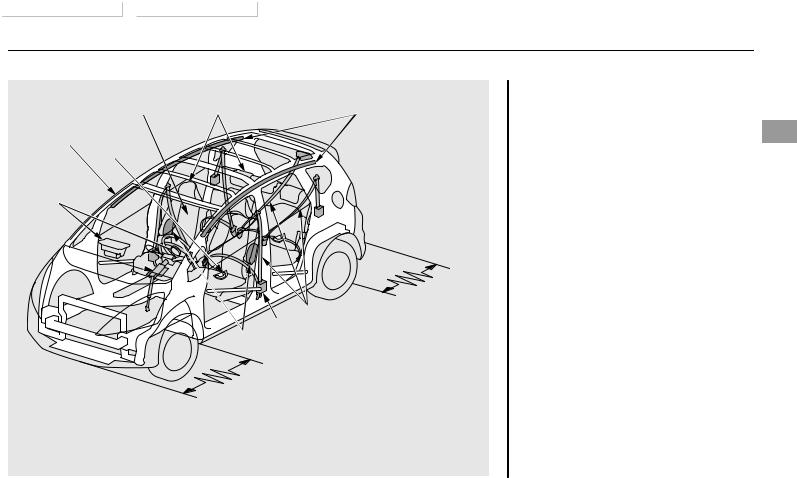
Main Menu |
|
Table Of Contents |
|
|
|
Your Vehicle's Safety Features
(3) |
(4) |
(9) |
(1)
(11)
(7)
(5) 


|
|
(2) |
(8) (10) |
(6) |
|
(1) |
Safety Cage |
|
|
(2) |
Crush Zones |
|
(3) |
Seats and Seat-Backs |
(2) |
(4) |
Head Restraints |
(5) |
Collapsible Steering Column |
|
|
(6) |
Seat Belts |
|
(7) |
Front Airbags |
|
(8) |
Side Airbags |
|
(9) |
Side Curtain Airbags |
|
(10) Front Seat Belt Tensioners |
|
|
(11) Door Locks |
|
Your vehicle is equipped with many features that work together to protect you and your passengers during a crash.
Some features do not require any action on your part. These include a strong steel framework that forms a safety cage around the passenger compartment, front and rear crush zones, a collapsible steering column, and tensioners that tighten the front seat belts in a crash.
However, you and your passengers can't take full advantage of these features unless you remain sitting in a proper position and always wear your seat belts. In fact, some safety features can contribute to injuries if they are not used properly.
The following pages explain how you can take an active role in protecting yourself and your passengers.
Safety Passenger and Driver
2009 Fit |
7 |

Main Menu |
|
Table Of Contents |
|
|
|
Your Vehicle's Safety Features
Seat Belts
Your vehicle is equipped with seat belts in all seating positions.
Your seat belt system also includes an indicator on the instrument panel and a beeper to remind you and your passengers to fasten your seat belts.
Why Wear Seat Belts
Seat belts are the single most effective safety device for adults and larger children. (Infants and smaller children must be properly restrained in child seats.)
Not wearing a seat belt properly increases the chance of serious injury or death in a crash, even though your vehicle has airbags.
In addition, most states and all Canadian provinces require you to wear seat belts.
Not wearing a seat belt properly increases the chance of serious injury or death in a crash, even though your vehicle has airbags.
Be sure you and your passengers always wear seat belts and wear them properly.
When properly worn, seat belts:
●Keep you connected to the vehicle so you can take advantage of the vehicle's built-in safety features.
●Help protect you in almost every type of crash, including:
frontal impacts
side impacts
rear impacts
rollovers
●Help keep you from being thrown against the inside of the vehicle and against other occupants.
●Keep you from being thrown out of the vehicle.
●Help keep you in a good position should the airbags ever deploy. A good position reduces the risk of injury from an inflating airbag and allows you to get the best advantage from the airbag.
Of course, seat belts cannot completely protect you in every crash. But in most cases, seat belts can reduce your risk of serious injury.
What You Should Do:
Always wear your seat belt, and make sure you wear it properly.
8 |
2009 Fit |
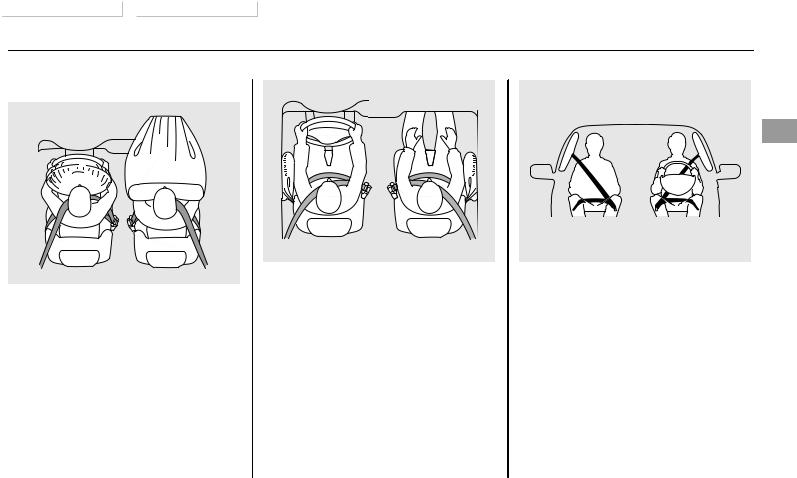
Main Menu |
|
Table Of Contents |
|
|
|
Your Vehicle's Safety Features
Airbags
Your vehicle has a supplemental restraint system (SRS) with front airbags to help protect the heads and chests of the driver and a front seat passenger during a moderate to severe frontal collision (see page 25 for more information on how your front airbags work).
Your vehicle also has side airbags to help protect the upper torso of the driver or a front seat passenger during a moderate to severe side impact (see page 28 for more information on how your side airbags work).
In addition, your vehicle has side curtain airbags to help protect the heads of the driver, front passenger, and passengers in the outer rear seating positions during a moderate to severe side or front impact (see page 30 for more information on how your side curtain airbags work).
Safety Passenger and Driver
CONTINUED
2009 Fit |
9 |

Main Menu |
|
Table Of Contents |
|
|
|
Your Vehicle's Safety Features
The most important things you need to know about your airbags are:
●Airbags do not replace seat belts.
They are designed to supplement the seat belts.
●Airbags offer no protection in rear impacts, or minor frontal or side collisions.
●Airbags can pose serious hazards.
To do their job, airbags must inflate with tremendous force. So while airbags help save lives, they can cause minor injuries or more serious or even fatal injuries if occupants are not properly restrained or sitting properly.
What you should do: Always wear your seat belt properly, and sit upright and as far back from the steering wheel as possible while allowing full control of the vehicle. A front passenger should move their seat as far back from the dashboard as possible.
The rest of this section gives more detailed information about how you can maximize your safety.
Remember, however, that no safety system can prevent all injuries or deaths that can occur in a severe crash, even when seat belts are properly worn and the airbags deploy.
10 |
2009 Fit |
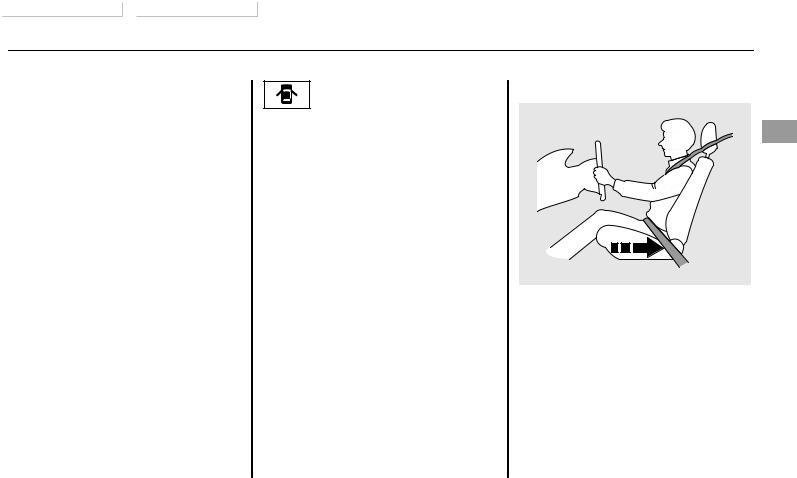
Main Menu |
|
Table Of Contents |
|
|
|
Protecting Adults and Teens
Introduction
The following pages provide instructions on how to properly protect the driver, adult passengers, and teenage children who are large enough and mature enough to drive or ride in the front.
See pages 34 38 for important guidelines on how to properly protect infants, small children, and larger children who ride in your vehicle.
1. Close and Lock the Doors
After everyone has entered the vehicle, be sure the doors and the tailgate are closed and locked.
Your vehicle has a door and tailgate open indicator on
the instrument panel to indicate when any door or the tailgate is not tightly closed.
Locking the doors reduces the chance of someone being thrown out of the vehicle during a crash, and it helps prevent passengers from accidentally opening a door and falling out.
Locking the doors and the tailgate also helps prevent an outsider from unexpectedly opening a door or the tailgate when you come to a stop.
See page 81 for how to lock the doors, and page 62 for how the door and tailgate open indicator works.
Some models have the auto door locking/unlocking feature. For more information, see page 83.
2. Adjust the Front Seats
Adjust the driver's seat as far to the rear as possible while allowing you to maintain full control of the vehicle. Have a front passenger adjust their seat as far to the rear as possible.
Safety Passenger and Driver
CONTINUED
2009 Fit |
11 |
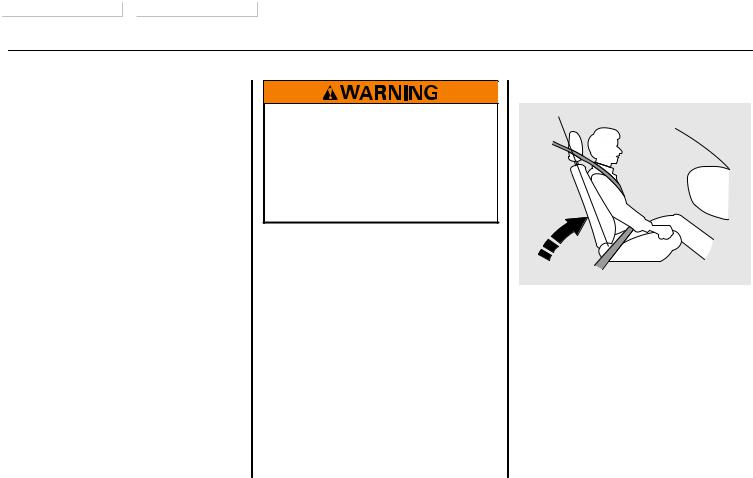
Main Menu |
|
Table Of Contents |
|
|
|
Protecting Adults and Teens
If you sit too close to the steering wheel or dashboard, you can be seriously injured by an inflating front airbag, or by striking the steering wheel or dashboard.
The National Highway Traffic Safety Administration and Transport Canada recommend that drivers allow at least 10 inches (25 cm) between the center of the steering wheel and the chest. In addition to adjusting the seat, you can adjust the steering wheel up and down, and in and out (see page 77).
If you cannot get far enough away from the steering wheel and still reach the controls, we recommend that you investigate whether some type of adaptive equipment may help.
Sitting too close to a front airbag can result in serious injury or death if the front airbags inflate.
Always sit as far back from the front airbags as possible.
Once a seat is adjusted correctly, rock it back and forth to make sure it is locked in position.
See page 93 for how to adjust the front seats.
3. Adjust the Seat-Backs
Adjust the driver's seat-back to a comfortable, upright position, leaving ample space between your chest and the airbag cover in the center of the steering wheel.
Passengers with adjustable seatbacks should also adjust their seatback to a comfortable, upright position.
12 |
2009 Fit |
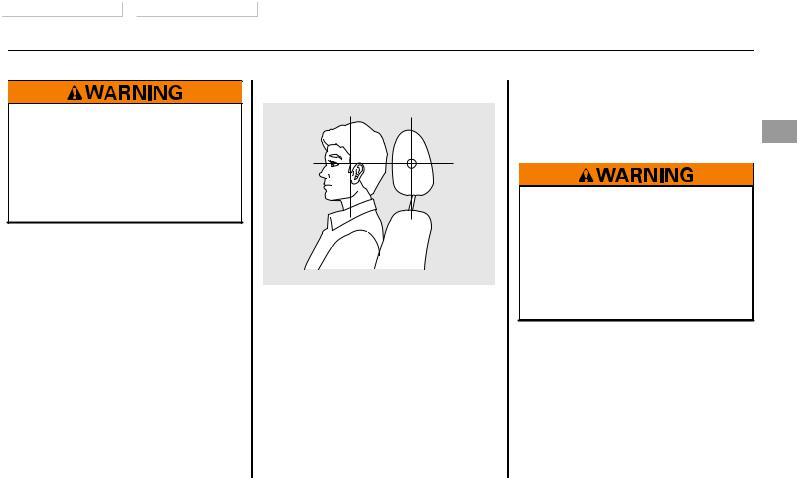
Main Menu |
|
Table Of Contents |
|
|
|
Protecting Adults and Teens
Reclining the seat-back too far can result in serious injury or death in a crash.
Adjust the seat-back to an upright position, and sit well back in the seat.
Reclining a seat-back so that the shoulder part of the belt no longer rests against the occupant's chest reduces the protective capability of the belt. It also increases the chance of sliding under the belt in a crash and being seriously injured. The farther a seat-back is reclined, the greater the risk of injury.
See page 93 for how to adjust the seat-backs.
4. Adjust the Head Restraints
Adjust the driver's head restraint so the center of the back of your head rests against the center of the restraint.
Have passengers adjust their head restraints properly as well. Taller persons should adjust their restraint as high as possible.
When a passenger is seated in the rear center seating position, make sure the center head restraint is properly positioned.
Improperly positioning head restraints reduces their effectiveness and you can be seriously injured in a crash.
Make sure head restraints are in place and positioned properly before driving.
Properly adjusted head restraints will help protect occupants from whiplash and other crash injuries.
See page 94 for how to adjust the head restraints and how the driver's and front passenger's active head restraints work.
Safety Passenger and Driver
2009 Fit |
13 |

Main Menu |
|
Table Of Contents |
|
|
|
Protecting Adults and Teens
5. Fasten and Position the Seat Belts
Insert the latch plate into the buckle, then tug on the belt to make sure the belt is securely latched. Check that the belt is not twisted, because a twisted belt can cause serious injuries in a crash.
The seat belt in the center position of the back seat can be unlatched and retracted to allow the back seat to be folded up or down. This seat belt should be latched whenever the seatback is in an upright position. See page 99 for how to unlatch and relatch the seat belt.
Position the lap part of the belt as low as possible across your hips, then pull up on the shoulder part of the belt so the lap part fits snugly. This lets your strong pelvic bones take the force of a crash and reduces the chance of internal injuries.
If necessary, pull up on the belt again to remove any slack, then check that the belt rests across the center of your chest and over your shoulder.
This spreads the forces of a crash over the strongest bones in your upper body.
Improperly positioning the seat belts can cause serious injury or death in a crash.
Make sure all seat belts are properly positioned before driving.
If the seat belt touches or crosses your neck, or if it crosses your arm instead of your shoulder, you need to adjust the seat belt anchor height.
14 |
2009 Fit |

Main Menu |
|
Table Of Contents |
|
|
|
Protecting Adults and Teens
RELEASE BUTTONS
The front seats have adjustable seat belt anchors. To adjust the height of an anchor, squeeze the two release buttons, and slide the anchor up or down as needed (it has four positions).
Never place the shoulder portion of a lap/shoulder belt under your arm or behind your back. This could cause very serious injuries in a crash.
If a seat belt does not seem to work properly, it may not protect the occupant in a crash.
No one should sit in a seat with an inoperative seat belt. Using a seat belt that is not working properly can result in serious injury or death. Have your dealer check the belt as soon as possible.
See page 18 for additional information about your seat belts and how to take care of them.
6. Maintain a Proper Sitting Position
After all occupants have adjusted their seats and head restraints, and put on their seat belts, it is very important that they continue to sit upright, well back in their seats, with their feet on the floor, until the vehicle is parked and the engine is off.
Sitting improperly can increase the chance of injury during a crash. For example, if an occupant slouches, lies down, turns sideways, sits forward, leans forward or sideways, or puts one or both feet up, the chance of injury during a crash is greatly increased.
CONTINUED
Safety Passenger and Driver
2009 Fit |
15 |
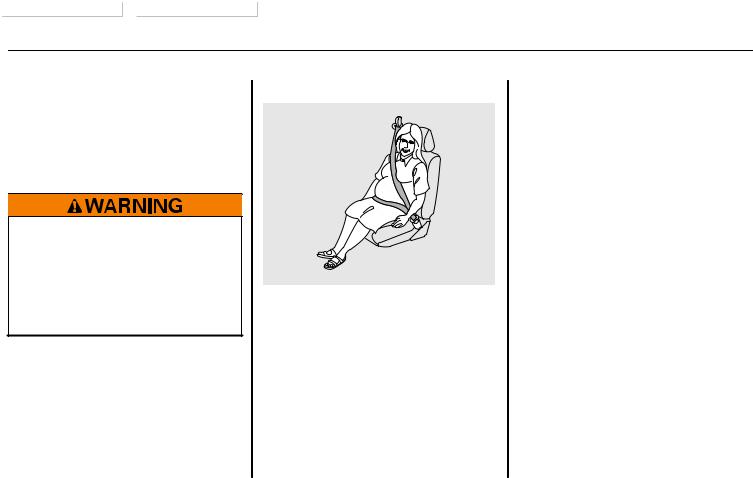
Main Menu |
|
Table Of Contents |
|
|
|
Protecting Adults and Teens
In addition, an occupant who is out of position in the front seat can be seriously or fatally injured in a crash by striking interior parts of the vehicle or being struck by an inflating front airbag.
Sitting improperly or out of position can result in serious injury or death in a crash.
Always sit upright, well back in the seat, with your feet on the floor.
Advice for Pregnant Women
If you are pregnant, the best way to protect yourself and your unborn child when driving or riding in a vehicle is to always wear a seat belt, and keep the lap part of the belt as low as possible across the hips.
When driving, remember to sit upright and adjust the seat as far back as possible while allowing full control of the vehicle. When riding as a front passenger, adjust the seat as far back as possible.
This will reduce the risk of injuries to both you and your unborn child that can be caused by a crash or an inflating front airbag.
Each time you have a checkup, ask your doctor if it's okay for you to drive.
16 |
2009 Fit |

Main Menu |
|
Table Of Contents |
|
|
|
Protecting Adults and Teens
Additional Safety Precautions
●Never let passengers ride in the cargo area or on top of a foldeddown back seat. If they do, they could be very seriously injured in a crash.
●Never let passengers ride in the area in front of a folded-up rear seat or on top of a folded-down rear seat. If they do, they could be very seriously injured in a crash.
●Passengers should not stand up or change seats while the vehicle is moving. A passenger who is not wearing a seat belt during a crash or emergency stop can be thrown against the inside of the vehicle, against other occupants, or out of the vehicle.
●Two people should never use the same seat belt. If they do, they could be very seriously injured in a crash.
●Do not put any accessories on seat belts. Devices intended to improve occupant comfort or reposition the shoulder part of a seat belt can reduce the protective capability of the belt and increase the chance of serious injury in a crash.
●Do not place hard or sharp objects between yourself and a front airbag. Carrying hard or sharp objects on your lap, or driving with a pipe or other sharp object in your mouth, can result in injuries if your front airbag inflates.
●Keep your hands and arms away from the airbag covers. If your hands or arms are close to an airbag cover, they could be injured if the airbag inflates.
●Do not attach or place objects on the front airbag covers. Objects on the covers marked ‘‘ SRS AIRBAG ’’ could interfere with the proper operation of the airbags or
be propelled inside the vehicle and hurt someone if the airbags inflate.
●Do not attach hard objects on or near a door. If a side airbag or a side curtain airbag inflates, a cup holder or other hard object attached on or near the door could be propelled inside the vehicle and hurt someone.
Safety Passenger and Driver
2009 Fit |
17 |

Main Menu |
|
Table Of Contents |
|
|
|
Additional Information About Your Seat Belts
Seat Belt System Components
Your seat belt system includes lap/ shoulder belts in all seating positions. The front seat belts are also equipped with automatic seat belt tensioners.
This system uses the same sensors as the front airbags to monitor whether the front seat belts are latched or unlatched, and how much weight is on the front passenger's seat (see page 27 ).
The seat belt system includes an indicator on the instrument
panel and a beeper to remind you and your passengers to fasten your seat belts.
This system monitors the front seat belts. If you turn the ignition switch to the ON (II) position before your seat belt is fastened, the beeper will sound and the indicator will flash. If your seat belt is not fastened before the beeper stops, the indicator will stop flashing but remain on.
If a front passenger does not fasten their seat belt, the indicator will come on about 6 seconds after the ignition switch is turned to the ON (II) position.
If either the driver or a front passenger does not fasten their seat belt while driving, the beeper will sound and the indicator will flash again at regular intervals.
When no one is sitting in the front passenger's seat, or a child or small adult is riding there, the indicator should not come on and the beeper should not sound.
If the indicator comes on or the beeper sounds when the driver's seat belt is latched and there is no front seat passenger and no items on the front seat, something may be interfering with the monitoring system. Look for and remove:
●Any items under the front passenger's seat.
●Any object(s) hanging on the seat or in the seat-back pocket.
●Any object(s) touching the rear of the seat-back.
If no obstructions are found, have your vehicle checked by a dealer.
18 |
2009 Fit |
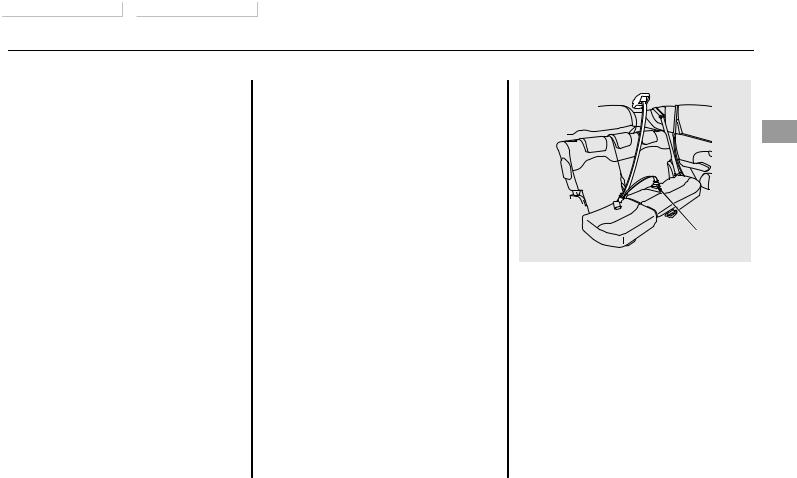
Main Menu |
|
Table Of Contents |
|
|
|
Additional Information About Your Seat Belts
Lap/Shoulder Belt
The lap/shoulder belt goes over your shoulder, across your chest, and across your hips.
To fasten the belt, insert the latch plate into the buckle, then tug on the belt to make sure the buckle is latched (see page 14 for how to properly position the belt).
To unlock the belt, press the red PRESS button on the buckle. Guide the belt across your body so that it retracts completely. After exiting the vehicle, be sure the belt is out of the way and will not get closed in the door.
All seat belts have an emergency locking retractor. In normal driving, the retractor lets you move freely in your seat while it keeps some tension on the belt. During a collision or sudden stop, the retractor automatically locks the belt to help restrain your body.
The seat belts in all positions except the driver's have a lockable retractor that must be activated to secure a child seat (see page 45).
If the shoulder part of the belt is pulled all the way out, the lockable retractor will activate. The belt will retract, but it will not allow the passenger to move freely.
To deactivate the lockable retractor, unlatch the buckle and let the seat belt fully retract. To refasten the seat belt, pull it out only as far as needed.
DETACHABLE
ANCHOR
The lap/shoulder belt in the center seating position on the rear seat is equipped with a detachable seat belt that has two parts: a small latch plate and an anchor buckle.
The detachable seat belt should normally be latched whenever the seat-backs are in an upright position. For more information about the detachable seat belt, see page 99.
Safety Passenger and Driver
2009 Fit |
19 |
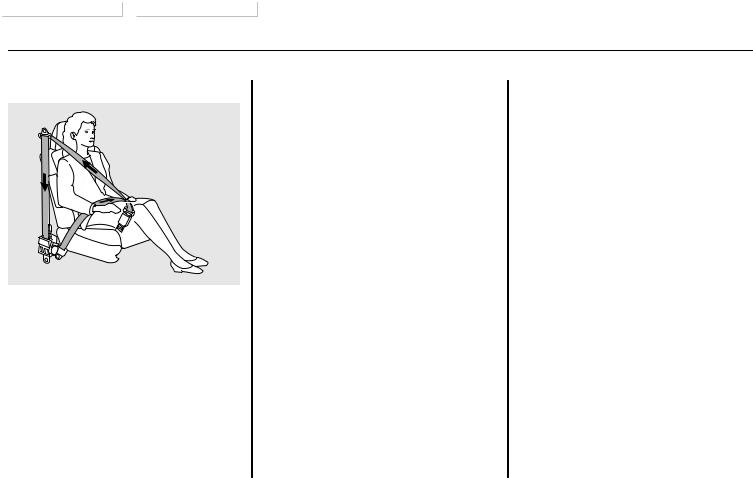
Main Menu |
|
Table Of Contents |
|
|
|
Additional Information About Your Seat Belts
Automatic Seat Belt Tensioners
For added protection, the front seat belts are equipped with automatic seat belt tensioners. When activated, the tensioners immediately tighten the belts to help hold the driver and a front passenger in position.
The tensioners are designed to activate in any collision severe enough to cause the front airbags to deploy.
If a side curtain airbag deploys during a side impact, the tensioner on that side of the vehicle will also deploy.
The tensioners can also be activated during a collision in which the front airbags do not deploy. In this case, the airbags would not be needed, but the additional restraint could be helpful.
When the tensioners are activated, the seat belts will remain tight until they are unbuckled.
Seat Belt Maintenance
For safety, you should check the condition of your seat belts regularly.
Pull each belt out fully, and look for frays, cuts, burns, and wear. Check that the latches work smoothly and the belts retract easily. If a belt does not retract easily, cleaning the belt may correct the problem (see page 267). Any belt that is not in good condition or working properly will not provide good protection and should be replaced as soon as possible.
Honda provides a limited warranty on seat belts. See your Honda Warranty Information booklet for details.
20 |
2009 Fit |
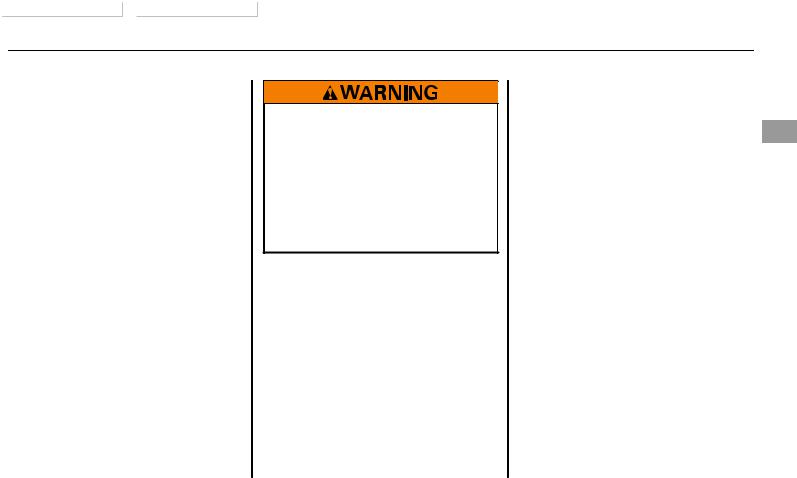
Main Menu |
|
Table Of Contents |
|
|
|
Additional Information About Your Seat Belts
If a seat belt is worn during a crash, it must be replaced by your dealer. A belt that has been worn during a crash may not provide the same level of protection in a subsequent crash.
The dealer should also inspect the anchors for damage and replace them if needed. If the automatic seat belt tensioners activate during a crash, they must be replaced.
Not checking or maintaining seat belts can result in serious injury or death if the seat belts do not work properly when needed.
Check your seat belts regularly and have any problem corrected as soon as possible.
Safety Passenger and Driver
2009 Fit |
21 |

|
Main Menu |
Table Of Contents |
|
|
|
|
Additional Information About Your Airbags |
|
|
|
|||
Airbag System Components |
|
|
|
|
||
|
|
|
(8) |
(9) |
|
(10) |
|
|
|
|
|
(2) |
|
|
|
|
|
|
(11) |
|
|
|
|
|
|
|
|
|
|
(12) |
|
|
|
(5) |
|
|
|
|
|
|
|
|
|
(1) |
|
|
|
|
|
|
(3) |
|
|
|
|
(1) |
Driver's Front Airbag |
|
|
|
|
|
(2) |
Passenger's Front Airbag |
|
|
|
|
|
(3) |
Control Unit |
|
(6) |
|
|
|
(4) |
Front Seat Belt Tensioners |
|
|
(4) |
||
(5) |
Side Airbags |
|
|
|
|
|
(6) |
Driver's Seat Position Sensor |
|
|
|
|
|
(7) |
Front Passenger's Weight Sensors |
|
|
|
|
|
(8) |
Front Impact Sensors |
|
|
|
(7) |
|
(9) |
Passenger Airbag Off Indicator |
|
|
|
||
(10) |
Occupant Position Detection System (OPDS) Sensors |
|
|
(11) |
Front Passenger's Weight Sensors/OPDS Sensors Control Unit |
(5) |
|
(12) |
Supplemental Restraint System (SRS) Indicator |
(4) |
|
22 |
2009 |
Fit |
|
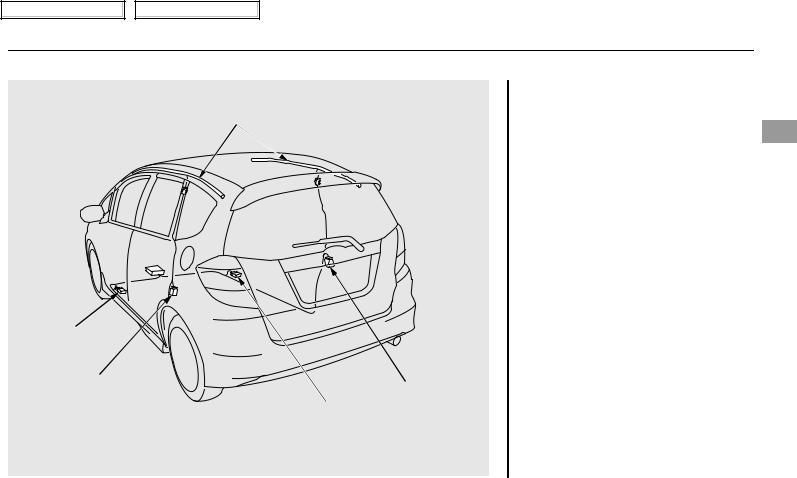
Main Menu |
Table Of Contents |
|
|
|
|
Additional Information About Your Airbags |
|
|
|
Your airbag system includes: |
|
|
(13) |
● |
Two SRS (supplemental restraint |
|
|
|
system) front airbags. The driver's |
|
|
|
airbag is stored in the center of the |
|
|
|
steering wheel; the front |
|
|
|
passenger's airbag is stored in the |
|
|
|
dashboard. Both are marked ‘‘SRS |
|
|
|
AIRBAG’’ (see page 25). |
|
|
● |
Two side airbags, one for the |
|
|
|
driver and one for a front |
|
|
|
passenger. The airbags are stored |
|
|
|
in the outer edges of the seat- |
|
|
|
backs. Both are marked ‘‘SIDE |
|
|
|
AIRBAG’’ (see page 28). |
(14) |
|
● |
Two side curtain airbags, one for |
|
|
|
each side of the vehicle. The |
|
|
|
airbags are stored in the ceiling, |
(15) |
|
(15) |
above the side windows. The front |
|
and rear pillars are marked ‘‘SIDE |
||
|
|
(14) |
CURTAIN AIRBAG’’ (see page 30). |
|
|
|
|
(13)Side Curtain Airbags
(14)Side Impact Sensors (First)
(15)Side Impact Sensors (Second)
CONTINUED
Safety Passenger and Driver
2009 Fit |
23 |

Main Menu |
|
Table Of Contents |
|
|
|
Additional Information About Your Airbags
●Automatic front seat belt tensioners (see page 20).
●Sensors that can detect a moderate to severe front impact or side impact.
●Sensors that can detect whether a child is in the passenger's side airbag path and signal the control unit to turn the airbag off (see page 29).
●Sensors that can detect whether the driver's seat belt and the front passenger's seat belt are latched or unlatched (see page 18).
●A driver's seat position sensor that monitors the distance of the seat from the front airbag. If the seat is too far forward, the airbag will inflate with less force (see page 27).
●Weight sensors that monitor the weight on the front passenger's seat. If the weight is about 65 lbs (29 kg) or less (the weight of an infant or small child), the passenger's front airbag will be turned off (see page 27).
●A sophisticated electronic system that continually monitors and records information about the sensors, the control unit, the airbag activators, the seat belt tensioners, and driver and front passenger seat belt use when the ignition switch is in the ON (II) position.
●An indicator on the instrument panel that alerts you to a possible problem with your airbags, sensors, or seat belt tensioners (see page 30).
●An indicator on the instrument panel that alerts you that the passenger's side airbag has been turned off (see page 31).
●An indicator on the dashboard that alerts you that the passenger's front airbag has been turned off (see page 31).
●Emergency backup power in case your vehicle's electrical system is disconnected in a crash.
24 |
2009 Fit |
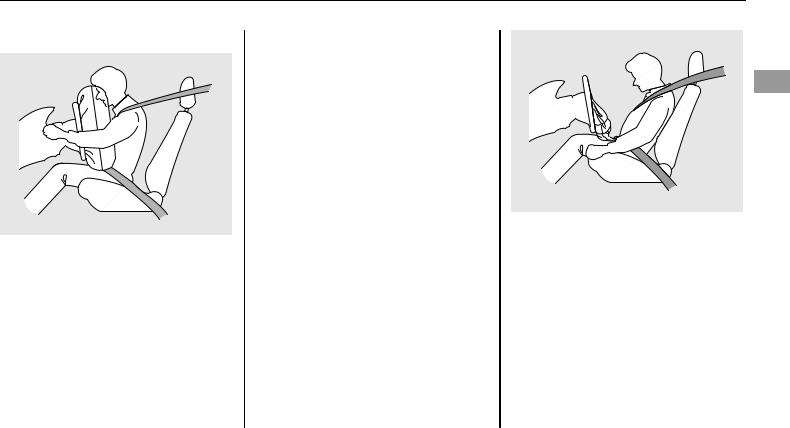
Additional Information About Your Airbags
How Your Front Airbags Work
If you ever have a moderate to severe frontal collision, sensors will detect the vehicle's rapid deceleration.
If the rate of deceleration is high enough, the control unit will instantly inflate the driver's and front passenger's airbags, at the time and with the force needed.
During a frontal crash, your seat belt restrains your lower body and torso, and the front airbag helps protect your head and chest.
Although both airbags normally inflate within a split second of each other, it is possible for only one airbag to deploy.
This can happen if the severity of a collision is at the margin, or threshold, that determines whether or not the airbags will deploy. In such cases, the seat belt will provide sufficient protection, and the supplemental protection offered by the airbag would be minimal.
Only the driver's airbag can deploy if there is no passenger in the front seat, or if the advanced airbag system has turned the passenger's airbag off (see page 27).
After inflating, the front airbags immediately deflate, so they won't interfere with the driver's visibility, or the ability to steer or operate other controls.
The total time for inflation and deflation is one-tenth of a second, so fast that most occupants are not aware that the airbags deployed until they see them lying in their laps.
Safety Passenger and Driver
CONTINUED
2009 Fit |
25 |

Main Menu |
|
Table Of Contents |
|
|
|
Additional Information About Your Airbags
After a crash, you may see what looks like smoke. This is actually powder from the airbag's surface. Although the powder is not harmful, people with respiratory problems may experience some temporary discomfort. If this occurs, get out of the vehicle as soon as it is safe to do so.
Dual-Stage Airbags
Your front airbags are dual-stage airbags. This means they have two inflation stages that can be ignited sequentially or simultaneously, depending on crash severity.
In a more severe crash, both stages will ignite simultaneously to provide the quickest and greatest protection.
In a less severe crash, one stage will ignite first, then the second stage will ignite a split second later. This provides longer airbag inflation time with a little less force.
Dual-Threshold Airbags
Your front airbags are also dualthreshold airbags. Airbags with this feature have two deployment thresholds that depend on whether sensors detect the occupant is wearing a seat belt or not.
If the occupant's belt is not latched, the airbag will deploy at a slightly lower threshold, because the occupant would need extra protection.
If the occupant's belt is latched, the airbag will deploy at a slightly higher threshold, when the airbag would be needed to supplement the protection provided by the seat belt.
26 |
2009 Fit |

Main Menu |
|
Table Of Contents |
|
|
|
Additional Information About Your Airbags
Advanced Airbags
Your front airbags are also advanced airbags. The main purpose of this feature is to help prevent airbagcaused injuries to short drivers and children who ride in front.
For both advanced airbags to work properly:
●Occupants must sit upright and wear their seat belts properly.
●Do not spill any liquids on or under the seats, cover the sensors, or put any objects or metal items under the front seats.
●Back-seat passengers should not put their feet under the front seats.
Failure to follow these instructions could damage the sensors or prevent them from working properly.
DRIVER'S
SEAT
POSITION
SENSOR
The driver's advanced front airbag system includes a seat position sensor under the seat. If the seat is too far forward, the airbag will inflate with less force, regardless of the severity of the impact.
If there is a problem with the sensor, the SRS indicator will come on, and the airbag will inflate in the normal manner regardless of the driver's seating position.
PASSENGER'S
SEAT WEIGHT
SENSORS
The passenger's advanced front airbag system has weight sensors under the seat. Although Honda does not encourage carrying an infant or small child in front, if the sensors detect the weight of an infant or small child (up to about 65 lbs or 29 kg), the system will automatically turn the passenger's front airbag off.
Be aware that objects placed on the passenger's seat can also cause the airbag to be turned off.
CONTINUED
Safety Passenger and Driver
2009 Fit |
27 |
